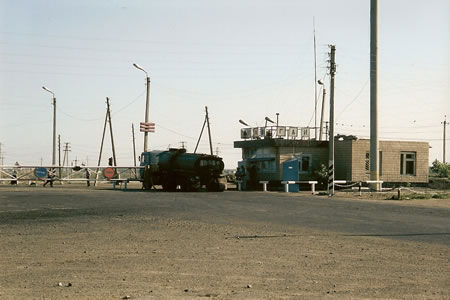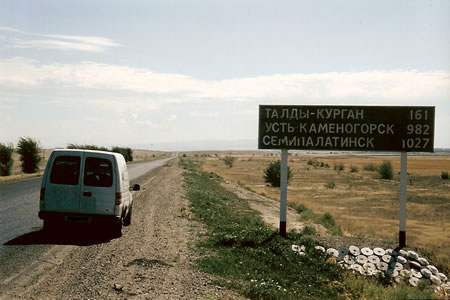English | Dutch |
|
| 22,000 kilometers in 8 weeks | |
Moscow (Russia), July 26th 1996 |
|
It is the summer of 1996 and we started a tour of 8 weeks through some of the countries that were part of the former Soviet Union. Special about this journey is, that we make this journey by private car with a western European license plate. We follow the following route: Kiev, Odessa, Sevastopol (all Ukraine), Astrakhan (on the shore of the Caspian sea in Russia), Aralsk (Kazakhstan), Tashkent, Samarkand, Bukhara (all Uzbekistan), Almaty, Semipalatinsk (Kazakhstan). Novosibirsk, Jekatarinburg en Moscow (all Russia). From Moscow, we drive back through Belarus to Western Europe. He total route amounts more than 22.000 kilometres, which we are going to drive in little bit more than 8 weeks.
The main reason to make this journey is the big interest we have in these countries of the former Soviet Union. For many years, the Soviet Union was something unknown behind the iron curtain. All we heard about this country was negative news. Main result is that most people in the west have an opinion about the former Soviet Union that is not very positive. We like to experience ourselves how it really is behind the iron curtain. There is very little known about the travel infrastructure in these countries. That is the reason why we decided to make the journey by own car. We take all kind of supplies to make sure that we are self-sufficient. This means that we take things like a tent, cooking equipment and spare parts for the car. With a lot of effort we also managed to buy an atlas for the former Soviet Union. This was a hell of a job because maps are rare. In the former Soviet Union the central government didn’t want to make the Soviet people too wise about the topography of their own country. The prohibition of maps was not only related to maps of the country, but also maps of cities. |
|
 |
|
One of the many traffic police checkpoints (GAI) in the former Soviet Union |
|
| Travel through the former Soviet Union by car is an absolute adventure. The enormous size of the countries in combination with the history, friendly people and lack of other tourists, make these countries (especially outside the travelled cities of Moscow and St. Petersburg) a top destination. The local people have little experience with foreigners, which give the journey an extra dimension.
Outside the big cities there is no infrastructure for travellers. That means: no restaurants and hotels. That means that at the end of the day we drive into a small village in search for a house with a garden where we can pitch our tent. In most villages it is easy to find a family who is open for this. Regularly, the whole village comes out to take a look at our tent and cooking activities. In some villages there were people who never saw a tent before. The result was that the first walked a couple of circles around the tent and touching it, before the asked us permission to enter the tent to inspect the inside. Travelling over the highways in the former Soviet Union has its hooks and eyes. Big parts of the roads are not surfaced, or the quality is so bad, that sandy paths are originated along the official highway. Not for only a couple of kilometres, but for hundreds of kilometres. Having a full tank of gasoline is something you always have in mind, because you never know where you will be able to fill your tank (there are no signs along the road with information about petrol stations). We use the strategy to fill up wherever possible, even if the tank is more than half full. We also brought some jerry cans as backup. The petrol stations are often not more than a (tanker) truck beside the road. We use a panty hose to filter the gasoline to be sure that no big ‘parts’ enter the tank of the car. But there are also invisible problems. Often the gasoline is mixed with water to increase their profitability. Filling up at the official petrol station is also amazing. The process goes as follows. You park your car at one of the refuelling units. Than you go to the cash register to order a specific amount of litres gasoline and pay it. The cash register is not more than a very small hole of 15 by 15 centimetres in a wall. The hole is covered by glass or plastic. On the other side of the hole sits the cashier. Through this hole you have to yell the amount of litres you want. Besides that, there is a small drawer system to pay the gasoline. Subsequently you go back to you car and start refuelling. Nothing special yet you would say. The special part starts at the moment that the car is filled up. You expect that the system will automatically shut down because full is full. That is not the case. If you ordered and paid for 50 litres, you will get 50 litres. He system only stops after the complete 50 litres left the hose. The result is that many litres flow into the nature making the gasoline station a big mess. | |
 |
|
A little bit more than 1000 kilometres to go to Semipalatinsk |
|
The traffic police (GAI) in the former Soviet Union is notorious. These civil servants are bad paid and for that reason they try to increase their income by issuing tickets to unsuspecting travellers. Believe me, you can get tickets for things you never thought you could get a ticket for. The money ends of course in his personal wallet. Most tickets are limited to a couple of dollar, so most of the times we just pay and continue our journey. It becomes more serious if they confiscate your passport of driving license, or ask for a lot of money. The police officers often use the same strategy. At the moment they stop you they are very friendly. They want to know where you come from and are very interested in your motivation to visit their country. After a short friendly chat they ask for your papers too see if your visa is fine. After handing over the papers, the mood changes dramatically. Your passport or driving license ends in his breast pocket and from that moment on he wants money. Than the battle starts to get the papers back with making a real fight or paying a huge amount of money. During the journey we developed a lot of experience to get the documents back. It is often the combination of the following actions: 1. Mention that you know the ambassador of your country and that you will phone him to make a complaint; 2. Take a pen and paper and start writing down the number of his badge, the license plate number of his car and ask him for his name; 3. Sit down on the ground in front of his police car and tell him you will not pay and will not leave before you get the documents back. Do not try to make a photo of him, because it will make your situation worse. The amount you have to pay at the end can be limited by putting only a couple of dollars in your wallet together with a credit card. Hand over the wallet and tell the police officer that you have no more cash than a couple of dollars because you use a credit card for your expenditures. In 9 of the 10 cases he will take all the cash money out of the wallet and hand over the wallet to you together with the documents. From that moment on you can continue with your journey till the next GAI officer. | |